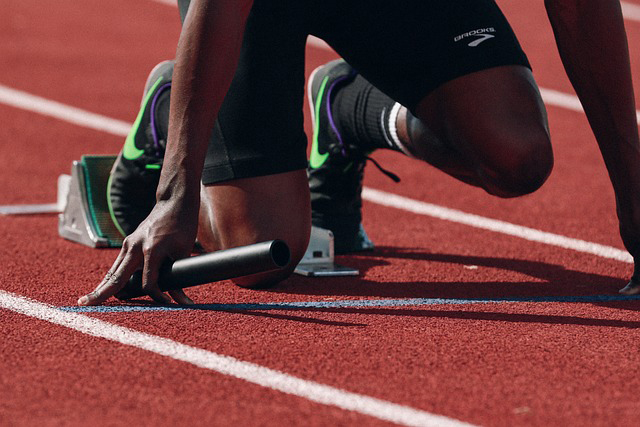VO2 max vs Anaerobic max
VO2 max is like your body’s endurance superhero, measuring how much oxygen your body can use during intense exercise. It’s all about how efficiently your body can keep going during activities like running or cycling.
On the other hand, anaerobic max is your body’s power booster. It’s about how much energy your muscles can produce without needing oxygen. Think of it as the fuel for quick bursts of activity, like sprinting or lifting something heavy.
So, while VO2 max helps you keep going for longer periods, anaerobic max gives you that extra oomph for short, powerful movements.

Anaerobic max
Anaerobic max is your body’s ability to perform short bursts of intense activity without relying on oxygen for energy. It’s like a super quick burst of power that doesn’t need oxygen to fuel your muscles.
Think of it as the energy you use when you sprint as fast as you can for a short distance, lift a heavy weight, or jump as high as possible. These activities tap into your anaerobic max because they demand a lot of power in a short amount of time.
Unlike aerobic activities like jogging or cycling, which rely on oxygen for energy and can be sustained for longer periods, anaerobic max activities are all about quick bursts of energy that don’t last long.
Improving your anaerobic max involves training your muscles to work more efficiently in these short, intense bursts. This can be done through exercises like sprinting, jumping, or lifting weights at a high intensity for short intervals.
While aerobic fitness is important for endurance activities, anaerobic max is crucial for things like sprinting, jumping, or any activity that requires sudden bursts of power. So, if you want to get better at those quick, powerful movements, focusing on improving your anaerobic max is the way to go!

VO2 max
VO2 max is like your body’s supercharger for endurance! It’s the maximum amount of oxygen your body can use during intense exercise. Imagine it as your body’s oxygen powerhouse.
When you’re pushing yourself during a tough workout, your muscles need oxygen to keep going. VO2 max measures how efficiently your body can deliver that oxygen to your muscles. The higher your VO2 max, the better your endurance.
You can think of it as the ultimate measure of your cardio fitness. Athletes with high VO2 max levels can keep going and going, whether they’re running, cycling, or doing any activity that requires stamina.
To improve your VO2 max, you need to train smart. That means doing exercises that get your heart pumping and your lungs working hard, like running, cycling, or swimming. The more you challenge your body with these kinds of workouts, the more your VO2 max can improve.
So, if you want to boost your endurance and feel like you can keep going for miles, focusing on increasing your VO2 max is the way to go!
VO2 max and Anaerobic max Comprasion
VO2 max, or maximal oxygen uptake, refers to the maximum amount of oxygen an individual can utilize during intense exercise, while anaerobic max pertains to the maximum capacity for energy production without oxygen.
- VO2 max primarily measures aerobic fitness, indicating the efficiency of the cardiovascular and respiratory systems in delivering oxygen to muscles, whereas anaerobic max reflects the capacity of muscles to generate energy in the absence of oxygen.
- VO2 max testing typically involves endurance activities like running or cycling, focusing on sustained effort, while anaerobic max assessments often involve short bursts of high-intensity activities such as sprinting or weightlifting.
- VO2 max is a key indicator of aerobic endurance and is crucial for athletes engaged in prolonged activities like marathons or cycling races, whereas anaerobic max is essential for sports requiring quick bursts of power and strength like sprinting or weightlifting.
- The physiological adaptations associated with improving VO2 max include increased lung capacity, cardiac output, and oxygen delivery to muscles, while improvements in anaerobic max are linked to enhanced muscle strength, power, and buffering capacity.
- Training to improve VO2 max typically involves longer duration, moderate to high-intensity workouts aimed at increasing cardiovascular efficiency and endurance, whereas training for anaerobic max often focuses on shorter, high-intensity intervals targeting fast-twitch muscle fibers and metabolic pathways.
- VO2 max is measured in milliliters of oxygen per kilogram of body weight per minute (ml/kg/min), providing a quantifiable metric for aerobic fitness levels, whereas anaerobic max is often assessed through tests like the Wingate Anaerobic Test, which measures peak power and anaerobic capacity.
- Individuals with high VO2 max values tend to excel in endurance-based activities requiring sustained effort over time, while those with high anaerobic max capabilities are often better suited for activities demanding short bursts of explosive power and strength.
- VO2 max is influenced by factors such as genetics, age, training status, and environmental conditions, while anaerobic max can be improved through specific training programs targeting anaerobic energy systems and muscle strength.
- Both VO2 max and anaerobic max play critical roles in overall fitness and athletic performance, and a balanced training regimen that addresses both aerobic and anaerobic capacities is essential for achieving optimal physical conditioning across various sports and activities.

Find more training topics https://x-steroids.com/forum/training-f9/
How can You increase Anaerobic max ?
To increase your anaerobic max, you’ll want to focus on specific training strategies that target the anaerobic energy systems and muscle strength. Here are some methods to help you raise your anaerobic max:
1. High-Intensity Interval Training (HIIT): Incorporate HIIT workouts into your routine, alternating between short bursts of maximum effort and periods of rest or low-intensity recovery. This type of training stimulates anaerobic energy production and improves your body’s ability to buffer lactic acid.
2. Sprint Training: Include sprint intervals in your training regimen. This could involve sprinting at maximum effort for short distances (e.g., 100 meters) followed by periods of rest or jogging. Gradually increase the intensity and duration of your sprints as your fitness improves.
3. Strength Training: Focus on building muscle strength and power through resistance training exercises such as squats, deadlifts, lunges, and plyometrics. These exercises enhance muscle recruitment and improve your ability to generate force, essential for anaerobic activities.
4. Plyometric Exercises: Incorporate plyometric drills like jump squats, box jumps, and explosive push-ups into your workouts. These exercises train fast-twitch muscle fibers, improving your explosiveness and power output.
5. Anaerobic Capacity Workouts: Perform specific workouts designed to target anaerobic capacity, such as the Tabata protocol (20 seconds of maximum effort followed by 10 seconds of rest, repeated for several cycles) or the Wingate Anaerobic Test (30 seconds of all-out cycling against resistance).
6. Circuit Training: Design circuit-style workouts that combine strength exercises with high-intensity cardio intervals. This approach challenges both your muscular strength and anaerobic energy systems while providing a cardiovascular workout.
7. Proper Nutrition: Ensure you’re fueling your body with adequate nutrients to support high-intensity training and muscle recovery. Consume carbohydrates for energy and protein for muscle repair and growth.
8. Rest and Recovery: Allow sufficient time for rest and recovery between intense training sessions to prevent overtraining and reduce the risk of injury. Adequate sleep and proper hydration are also essential for optimal performance and recovery.
9. Consistency and Progression: Gradually increase the intensity, duration, and frequency of your anaerobic training sessions over time to continue challenging your body and eliciting adaptations.
10. Seek Professional Guidance: Consider working with a certified personal trainer or coach who can design a customized training plan tailored to your goals, fitness level, and individual needs. They can provide guidance, motivation, and feedback to help you maximize your anaerobic potential safely and effectively.

How can You increase VO2 max ?
Increasing your VO2 max involves targeted training methods aimed at improving your body’s ability to utilize oxygen efficiently. Here’s how you can raise your VO2 max:
1. Cardiovascular Exercise: Engage in aerobic activities such as running, cycling, swimming, or rowing regularly. Aim for at least 150 minutes of moderate-intensity aerobic exercise or 75 minutes of vigorous-intensity aerobic exercise per week, as recommended by health guidelines.
2. Interval Training: Incorporate interval training into your workouts to challenge your cardiovascular system and improve VO2 max. Alternate between periods of higher intensity (e.g., running at a fast pace) and lower intensity (e.g., jogging or walking) to stimulate adaptations in your heart, lungs, and muscles.
3. Long, Slow Distance (LSD) Training: Include longer-duration, steady-state workouts in your routine to build endurance and increase your body’s capacity to utilize oxygen. These workouts help improve mitochondrial density and enhance oxygen delivery to muscles.
4. Fartlek Training: Try fartlek training, which involves varying your pace throughout a workout, mixing periods of fast running with slower recovery segments. This method can help improve both aerobic and anaerobic fitness while keeping workouts interesting and challenging.
5. Hill Training: Incorporate hill workouts into your routine to increase the intensity of your runs or cycling sessions. Running or cycling uphill requires greater oxygen uptake and can help improve VO2 max and overall cardiovascular fitness.
6. Cross-Training: Supplement your primary aerobic activities with cross-training exercises such as swimming, elliptical training, or stair climbing to reduce the risk of overuse injuries and provide variety in your training routine.
7. Strength Training: Include strength training exercises targeting major muscle groups to improve overall muscular endurance and efficiency. Stronger muscles can help support better posture and movement mechanics during aerobic activities, enhancing oxygen utilization.
8. Proper Nutrition: Maintain a balanced diet rich in carbohydrates, proteins, healthy fats, vitamins, and minerals to support energy production, muscle repair, and overall health. Stay hydrated before, during, and after workouts to optimize performance and recovery.
9. Rest and Recovery: Allow adequate time for rest and recovery between workouts to prevent overtraining and promote adaptation. Quality sleep is essential for muscle repair, hormone regulation, and overall recovery.
10. Progressive Overload: Gradually increase the duration, frequency, and intensity of your aerobic workouts over time to continually challenge your body and stimulate improvements in VO2 max. Incorporate periodic fitness assessments to track your progress and adjust your training plan accordingly.
By implementing these strategies consistently and progressively, you can enhance your VO2 max and improve your overall aerobic fitness level.








